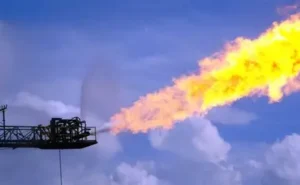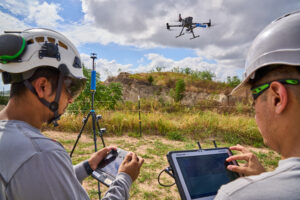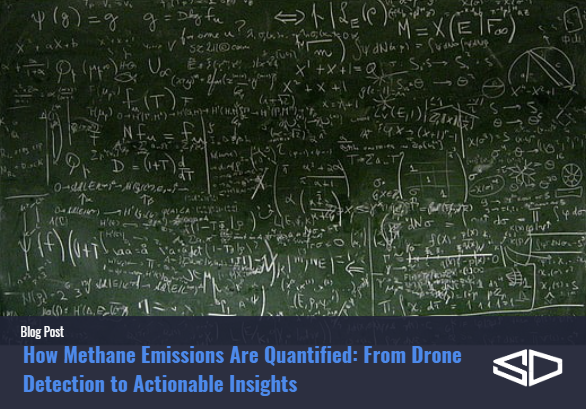See how SeekOps calculates emissions using real-time methane concentration and wind data, based on conservation of mass.
Read time: 5 minutes
Why Measuring Emissions Matters
Finding a leak is only half the story, knowing how much is leaking is what truly makes a difference.
In the world of emissions monitoring, quantification refers to the process of calculating how much methane is being released, by volume or mass, from a facility or piece of equipment. Whether it’s a small valve or a large storage tank, understanding the magnitude of a leak is critical for regulatory reporting, prioritizing repairs, and making informed decisions on environmental performance.
With climate regulations like OGMP 2.0 and EU MR being enforced more rigorously, and ESG targets growing more ambitious, accurate quantification isn’t just helpful, it’s essential.

From Sensing to Sizing: How It Works
SeekOps begins with drone-based surveys using our SeekIR® methane sensor. The drone flies a planned pattern over the site while continuously collecting real-time concentration measurements of methane in the atmosphere.
But detecting methane in the air doesn’t immediately tell us how much is being released at the source. We leverage a combination of advanced tools, including on-site wind measurements from ground sensors and real-time wind data collected directly by the drone’s onboard anemometer. This integration ensures that our quantification is based on actual wind conditions rather than assumptions which is a critical distinction that enhances accuracy, particularly in complex or variable environments. That’s where quantification algorithms come in.
We use a combination of:
Atmospheric modeling (to account for wind and dispersion),
Sensor positioning data (to locate the plume in 3D space),
Concentration readings (to measure the strength of the signal),
and flight telemetry (to understand how the drone moved during measurement).
We collect this data using our drone-mounted sensor and a high-resolution 3D anemometer placed on site. Then we apply proven mathematical models to turn those data points into a mass flow rate that is usually expressed in grams per second or standard cubic feet per hour.

It’s Not Guesswork: It’s Physics
Quantifying emissions involves applying principles of fluid dynamics, gas dispersion modeling, and mass balance equations. Think of it like reverse-engineering a puzzle: we see the effects in the air and work backward to figure out what kind of leak caused them.
Key considerations include:
Plume height and width
Ambient wind speed and direction
Stability of atmospheric conditions
Distance from the source
Our system adapts in real-time to changing field conditions and uses validated models that have been peer-reviewed and tested at facilities like METEC (Methane Emissions Technology Evaluation Center).
Using the Law of Conservation of Mass
Our measurements rely on a simple, powerful idea: what goes in must come out.
We define an invisible box, or “control volume”, around a facility or piece of equipment. By measuring the air and wind conditions upwind and downwind of this box, we can calculate the difference in methane and determine how much is leaking inside.
This approach is grounded in the conservation of mass, one of the most fundamental laws in physics.
Accuracy You Can Trust
At SeekOps, we’re proud that our quantification system has been third-party validated in blind testing environments, peer-reviewed in academic literature, and deployed in over a dozen countries and diverse climates.
Each SeekIR® sensor undergoes rigorous calibration and environmental validation, including testing across humidity (0–95% RH) and temperature (-20°C to 55°C) ranges. This ensures the system performs in extreme field conditions, whether in Arctic oilfields or equatorial landfills.
In independent comparisons, SeekOps has consistently demonstrated low measurement uncertainty and high repeatability, even for low-level emissions.
Scalable and Repeatable Data
One of the key benefits of our quantification process is that it’s repeatable over time. This allows facility operators to track emissions reductions after repairs, compare performance across assets or regions, demonstrate emissions improvement for ESG reports or regulatory compliance, and plan maintenance around the highest-volume sources first.
SeekOps leads the industry in application of these approaches with regard to the standardization of workflows, enabling compliance with a wide variety of initiatives globally. By turning emissions into measurable trends, we help our partners move from reactive to proactive emissions management.
Supporting Methane Intensity and Reconciliation
SeekOps quantification feeds into broader metrics like Methane Intensity (MI) or reconciliation of emissions to various, complex emission sources. With accurate site-level data, operators can benchmark performance, calculate carbon equivalencies, and report to frameworks like OGMP 2.0, EU MR, or EPA GHGRP.
Our quantification data can also support reconciliation with bottom-up inventories and mass balance models. This enables companies to align measurement-based and inventory-based methods more effectively, which is crucial for verification and audit-readiness.
Quantification Is Climate Action
The ability to quantify methane accurately transforms environmental responsibility from a guess into a guarantee. With SeekOps, operators gain the clarity to prove performance, meet compliance, and reduce emissions at scale—enabling operators to produce energy sustainably and responsibly. Every leak quantified is a step toward a cleaner, more transparent energy future.
Stay tuned for the next post in our series: “Understanding Uncertainty – How SeekOps Quantifies Confidence.”
Ready to turn emissions data into actionable insights?
Schedule a Walkthrough or Learn About Our Quantification Methods
Image Credits
Ken Doerr, Methane Emissions from Oil Tank, Flickr, Creative Commons Attribution 2.0 Generic (CC BY 2.0).
Equation Formula Math Physics Science Poster, Wallpaper Flare.
References
Corbett, A., & Smith, B. (2022). Study of a Miniature TDLAS System Onboard Two Unmanned Aircraft to Independently Quantify Methane Emissions from Oil and Gas Production Assets and Other Industrial Emitters. Atmosphere, 13(5), 804. https://doi.org/10.3390/atmos13050804
Mohammadloo, T. H., Jones, M., Van De Kerkhof, B., et al. (2024). Quantitative Estimate of Sources of Uncertainty in Drone-Based Methane Emission Measurements. https://doi.org/10.5194/egusphere-2024-1175
Dawson, K. W., Smith, B. J., Stocker, I., & Evans, P. (2024). Assessing the Application of Drone TDLAS Methane Emissions Monitoring Technology in the Intertropical Convergence Zone Using Machine Learning. APOGCE 2024. https://doi.org/10.2118/221317-MS
Hanson, R. K., Spearrin, R. M., & Goldenstein, C. S. (2016). Spectroscopy and Optical Diagnostics for Gases (Vol. 1). Springer. https://link.springer.com/book/10.1007/978-3-319-23252-2
Ravikumar, A. P., Wang, J., Sreedhara, S., et al. (2019). Single-blind inter-comparison of methane detection technologies: Results from the Stanford/EDF Mobile Monitoring Challenge. Elementa: Science of the Anthropocene, 7(1), 37. https://doi.org/10.1525/elementa.373


